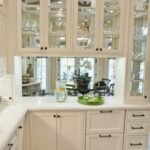How to Design a Functional Cabinet Layout
- By -Tonny Jack
- Posted on
- Posted in Cabinets
A well-designed cabinet layout combines functionality and style, ensuring that your storage solutions meet your daily needs while enhancing your space. Whether you’re working on a kitchen, bathroom, or living room, thoughtful planning is essential for creating a cabinet layout that is both practical and visually appealing. Here’s how to design a functional cabinet layout that works for your home.

Evaluate Your Storage Needs
Before diving into design, assess what you need to store. Consider the types and sizes of items you use frequently, such as cookware, cleaning supplies, or toiletries. Make a list of your must-haves to guide your cabinet design.
Measure Your Space
Accurate measurements are the foundation of any cabinet layout. Measure your room dimensions, including walls, ceilings, and existing fixtures. Factor in doorways, windows, and appliances that could affect the placement of cabinets.
Prioritize Accessibility
Arrange cabinets to make frequently used items easy to access. Place everyday essentials in lower cabinets or drawers at waist height. Reserve higher cabinets for less-used items like seasonal dishes or decorative pieces.
Incorporate Different Storage Types
A mix of cabinet styles adds both functionality and versatility. Combine open shelves, pull-out drawers, and closed cabinets to accommodate various storage needs. Use vertical storage options for taller items and deeper drawers for bulkier items.
Plan for Work Zones
In spaces like kitchens or workshops, divide your layout into zones based on activities. For example, in a kitchen, create separate zones for cooking, prepping, and cleaning. Ensure each zone has the necessary tools and supplies within easy reach.
Use Corner Space Wisely
Corners often become wasted space in cabinet layouts. Maximize their potential by installing lazy Susans, pull-out shelves, or corner drawers. These solutions make it easier to access items tucked away in hard-to-reach spots.
Consider Built-In Features
Modern cabinets can include built-in organizers for specific purposes, such as spice racks, knife holders, or trash bins. Incorporate these features to keep your layout streamlined and efficient.
Choose Durable Materials
Select cabinet materials that match your style and durability needs. Solid wood offers timeless appeal, while laminate or metal may be more budget-friendly and easy to maintain. Opt for finishes that resist scratches, moisture, and wear.
Optimize for Small Spaces
In smaller areas, every inch counts. Use floor-to-ceiling cabinets to maximize vertical space. Opt for sliding doors instead of swinging ones to save room. Use light colors and glass doors to create an open and airy feel.
Incorporate Lighting
Good lighting enhances functionality and highlights your cabinet design. Use under-cabinet lighting to brighten countertops and interior lighting for display cabinets. LED lights are energy-efficient and long-lasting.
Focus on Aesthetics
Your cabinet layout should complement your overall decor. Choose finishes, colors, and hardware that match the room’s style. Minimalist handles, sleek finishes, or bold colors can all elevate the design.
Plan for Future Needs
Think long-term when designing your cabinet layout. Consider how your storage needs might change over time. Flexible features like adjustable shelves and modular units can adapt to future demands.
Work With a Professional
For complex layouts or specialized requirements, consulting a professional can save time and ensure the best results. An experienced designer can help you balance aesthetics and functionality while avoiding costly mistakes.
Conclusion
Designing a functional cabinet layout requires careful planning and attention to detail. By assessing your needs, maximizing space, and incorporating practical features, you can create a cabinet layout that is both efficient and stylish, perfectly tailored to your lifestyle.



